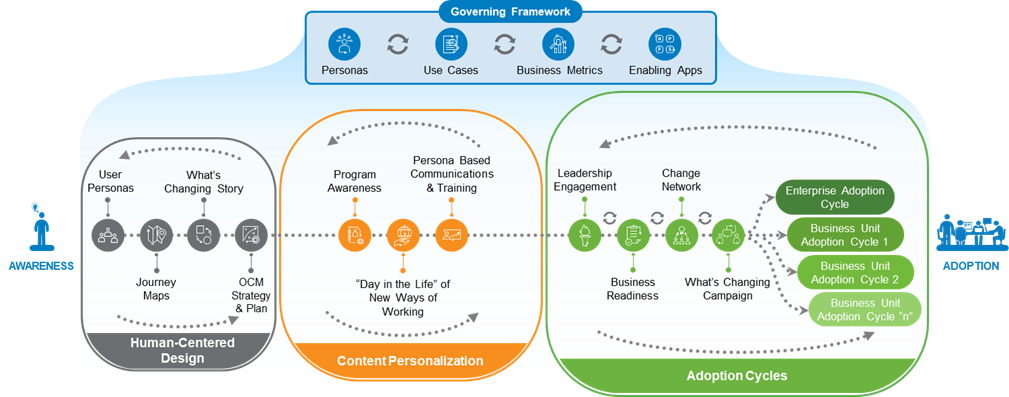Based on the extensive experience Infosys brings to the table working with leading companies globally, for any company undertaking an SAP S/4 HANA business transformation, the importance of Organizational Change Management (OCM) cannot be overstated. OCM is critical to ensuring that the journey to SAP S/4 HANA is successful and that the company can fully reap the benefits of its business transformation.
One of the primary reasons why OCM is critical in this context is that users do not always adapt easily to new software and related process changes. The transformational journey to SAP S/4 HANA is a significant change that will impact the entire organization, from business processes to roles and responsibilities. In our experience, it is essential to have a structured approach to manage this change and ensure that everyone, from leadership to users, are onboard with the new ways of working.
The first step in an effective OCM strategy for an SAP S/4 HANA journey is to assess the impact of the change on the organization. This includes identifying the key stakeholders who will be impacted by the change, including employees, customers, and suppliers. It is important to understand how the change will affect each group and to develop a plan to address any concerns or resistance they may have moving to these new ways of working
Next, it is essential to communicate the change effectively to all stakeholders. Communication cannot be limited to simply informing people about the upcoming transformation. Explaining the benefits of the new system and how it will impact their daily work is imperative to engaging stakeholders. Communication must be clear, concise, and fully integrated into a seamless adoption campaign throughout the transformational journey.
Training is another critical aspect that cannot be ignored. Employees will need to be trained on the new system and all related processes to ensure that they can perform their jobs effectively on day one. Tailored training, down to the role and module level, must be delivered in a way that is easily understood, informative, engaging, and interactive. The training also needs to be adaptive, self-paced and in the flow of work to support new users as they are onboarded to new roles through growth, job advancement and attrition.
Finally, it is essential to establish a change management governance structure which oversees the change journey. This structure includes a change management team that is responsible for implementing the OCM strategy and addressing all issues that arise. Regular communication and feedback channels with the business stakeholders, super-users/trainers and users must be established to ensure that everyone has a voice in the process and that issues are addressed promptly.
In conclusion, an effective OCM strategy that leads stakeholders on a Journey from Awareness to Adoption is critical to the success of an SAP S/4 HANA business transformation. By understanding the impact of the change, communicating effectively, providing quality training, and establishing a governance structure, companies can ensure that the business transformation will be as smooth as possible and that the benefits of the new system are fully realized. Managing stakeholders through the Awareness to Adoption journey during SAP S/4HANA transformation requires a pragmatic and tactical approach. To further expand on our Infosys OCM approach, we will be creating a series of supporting blogs that dig deeper into our proven adoption techniques which includes:
- Stakeholder Engagement & Communications Across the Journey
- Best in Class Training Approach
- Tracking & Measuring Business Readiness
- Change Management Office (CMO)

Fig. 1 – Infosys Consulting Digital Adoption Framework











